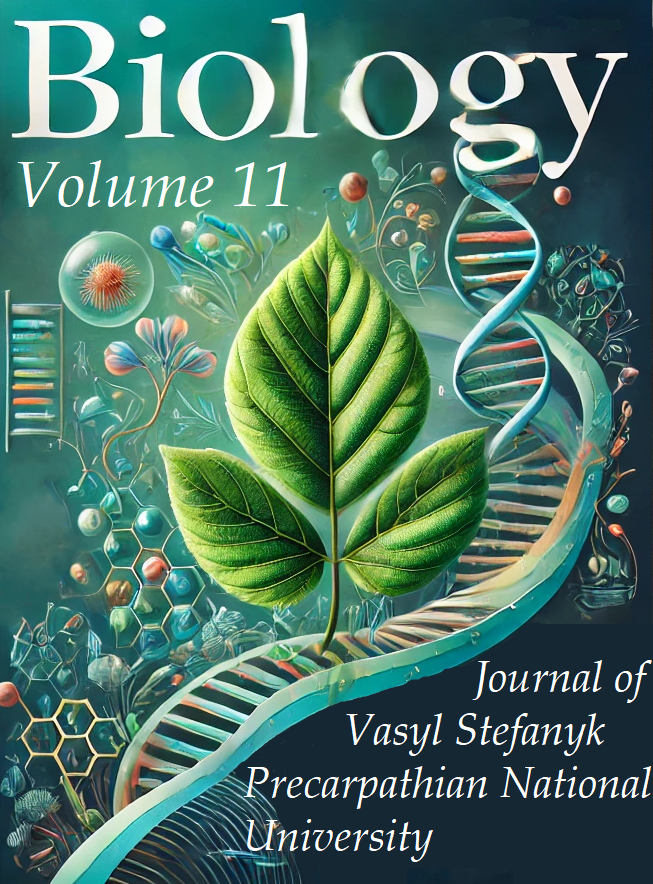Онтогенетична структура та насіннєва продуктивність Arnica montana L. в умовах Українських Карпат
DOI:
https://doi.org/10.15330/jpnubio.11.168-176Ключові слова:
Arnica montana L., онтогенетична структура, насіннєва продуктивність, екологічні фактори, Українські Карпати, охорона видівАнотація
У статті розглянуто особливості онтогенетичної структури та насіннєвої продуктивності Arnica montana L. у природних умовах Українських Карпат, що є ключовими аспектами для розуміння динаміки її популяцій і екологічних адаптацій. Визначено основні фактори, які впливають на життєздатність популяцій, включаючи кліматичні умови, висотну поясність, стан фітоценозів та інтенсивність антропогенного впливу. Здійснено аналіз просторового розподілу та вікової структури популяцій, що дозволяє оцінити рівень адаптивного потенціалу виду та його здатність до природного відтворення. Досліджено взаємозв'язок між висотною поясністю, структурою рослинного угруповання та показниками насіннєвого оновлення. Отримані дані засвідчують, що наявність сприятливих екологічних умов є визначальним фактором для забезпечення успішної регенерації виду. Встановлено, що в умовах середньогірних лук і субальпійської зони Arnica montana L. демонструє вищий рівень насіннєвої продуктивності порівняно з високогірними територіями, де спостерігається поступове зниження потенційної насіннєвої продуктивності внаслідок екологічних обмежень. Проаналізовано фазовий розвиток особин Arnica montana L. на різних онтогенетичних стадіях. Здійснено кількісний аналіз показників потенційної та актуальної насіннєвої продуктивності, а також рівня насіннєвого відтворення у різних екологічних нішах. Запропоновано комплекс заходів для збереження природних популяцій Arnica montana L. у регіоні. До таких заходів належать обмеження випасу худоби, регулювання рекреаційного навантаження, заборона збору лікарської сировини у природних місцях зростання та охорона ключових популяцій у заповідних територіях.
Посилання
Leoni V., Borgonovo G., Giupponi L., Bassoli A., Pedrali D., Zuccolo M., Rodari A., & Giorgi, A. (2021). Comparing wild and cultivated Arnica montana L. from the Italian Alps to explore the possibility of sustainable production using local seeds. Sustainability, 13, 3382. https://doi.org/10.3390/su13063382
Kimel K., Krauze-Baranowska M., Godlewska S., & Pobłocka-Olech L. (2020). HPLC-DAD-ESI/MS comparison of the chemical composition of flowers from two Arnica species grown in Poland. Herba Pol., 66, 1–10. http://dx.doi.org/10.2478/hepo-2020-0008.
Kriplani P., Guarve K., & Baghael U.S. (2017). Arnica montana L.—а plant of healing: Review. J. Pharm. Pharmacol., 69, 925–945. https://doi.org/10.1111/jphp.12724.
Sugier P., Sugier D., Sozinov O., Kołos A., Wołkowycki D., Plak A., & Budnyk O. (2019). Characteristics of plant communities, population features, and edaphic conditions of Arnica montana L. populations in pine forests of mid-eastern Europe. Acta Soc. Bot. Pol., 88, 3640. http://dx.doi.org/10.5586/asbp.3640.
Sugier P., Jakubowicz-Gil J., Sugier D., Kowalski R., Gawlik-Dziki U., Kołodziej B., & Dziki D. (2020). Chemical characteristics and anticancer activity of essential oil from Arnica montana L. rhizomes and roots. Molecules, 25, 1284. https://doi.org/10.3390/molecules25061284.
Duthen S., Gadéa A., Trempat P., Boujedaini N., & Fabre N. (2022). Comparison of the phytochemical variation of non-volatile metabolites within mother tinctures of Arnica montana prepared from fresh and dried whole plant using UHPLC-HRMS fingerprinting and chemometric analysis. Molecules, 27, 2737. https://doi.org/10.3390/molecules27092737.
Jakubowicz-Gil J., Ba˛dziul D., Langner E., Wertel I., Zajac A., & Rzeski, W. (2017). Temozolomide and sorafenib as programmed cell death inducers of human glioma cells. Pharmacol. Rep., 69, 779–787. https://doi.org/10.1016/j.pharep.2017.03.008.
Pljevljakuši´c D., Ranˇci´c D., Risti´c M., Vujisi´c L., Radanovi´c D., & Daji´c-Stevanovi´c Z. (2012). Rhizome and root yield of the cultivated Arnica montana L.: Chemical composition and histochemical localization of essential oil. Ind. Crops Prod., 39, 177–189. http://dx.doi.org/10.1016/j.indcrop.2012.02.030.
Flórez-Fernández N., Ferreira-Anta T., Torres M.D., & Domínguez H. (2021). Valorization of Arnica montana wastes after extraction of the ethanol tincture: Application in polymer-based matrices. Polymers, 13, 3121. https://doi.org/10.3390/polym13183121.
##submission.downloads##
Опубліковано
Як цитувати
Номер
Розділ
Ліцензія
Авторське право (c) 2024 CC BY-NC-ND 4.0

Ця робота ліцензується відповідно до Creative Commons Attribution-NonCommercial-NoDerivatives 4.0 International License.




